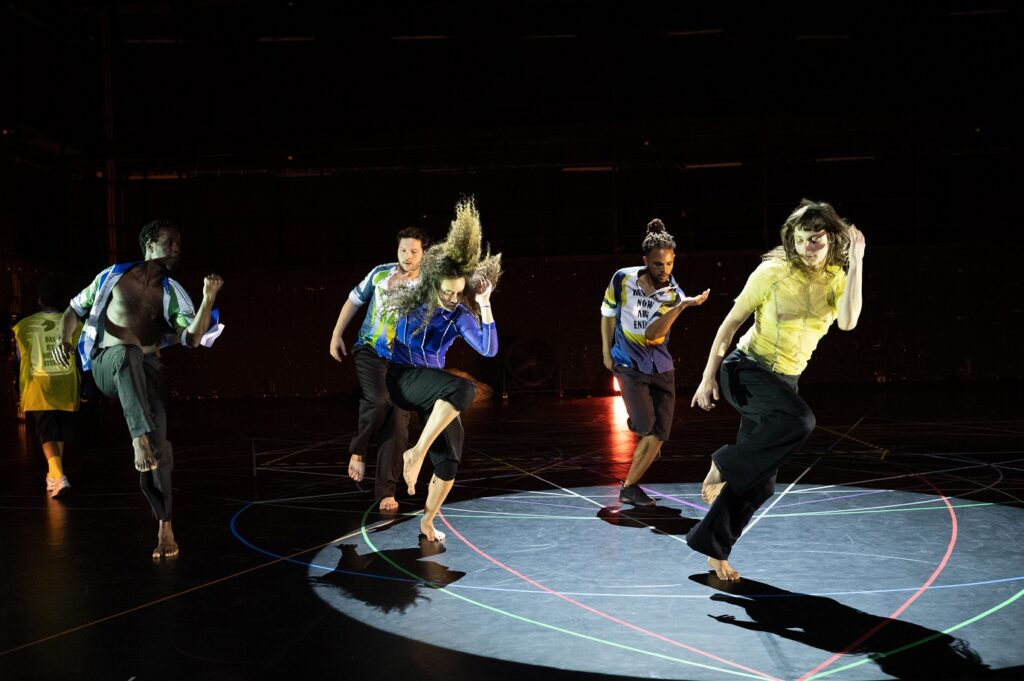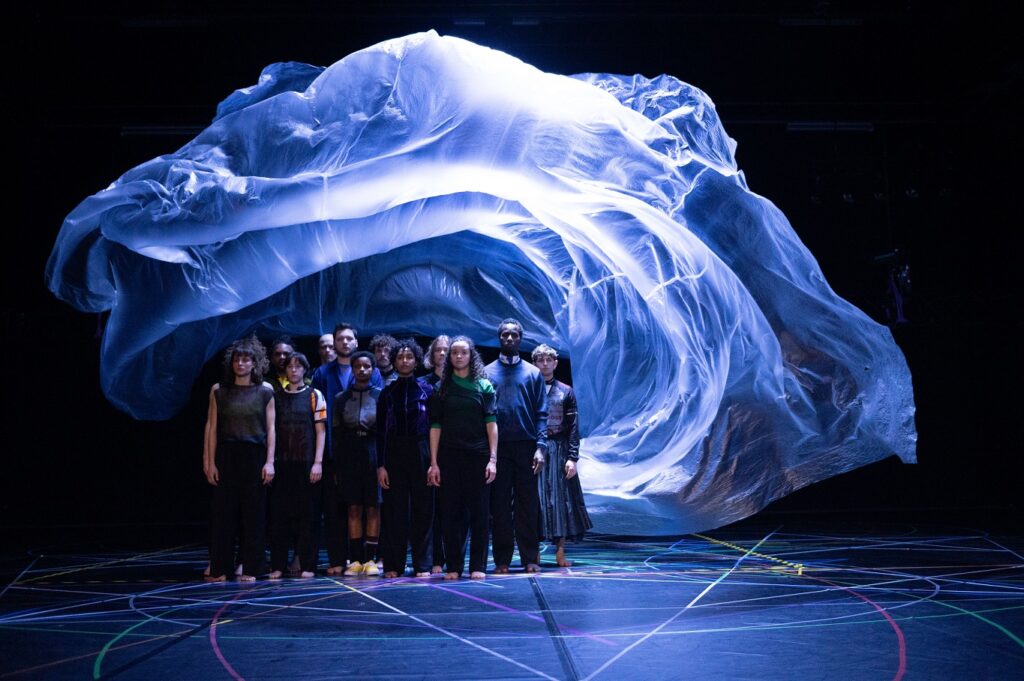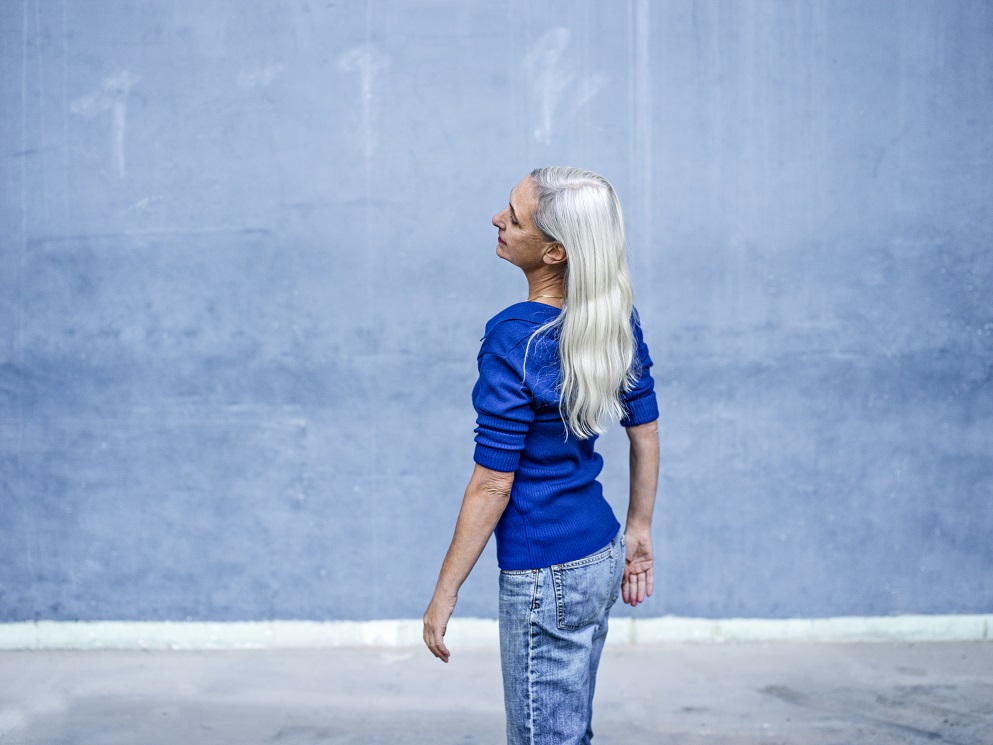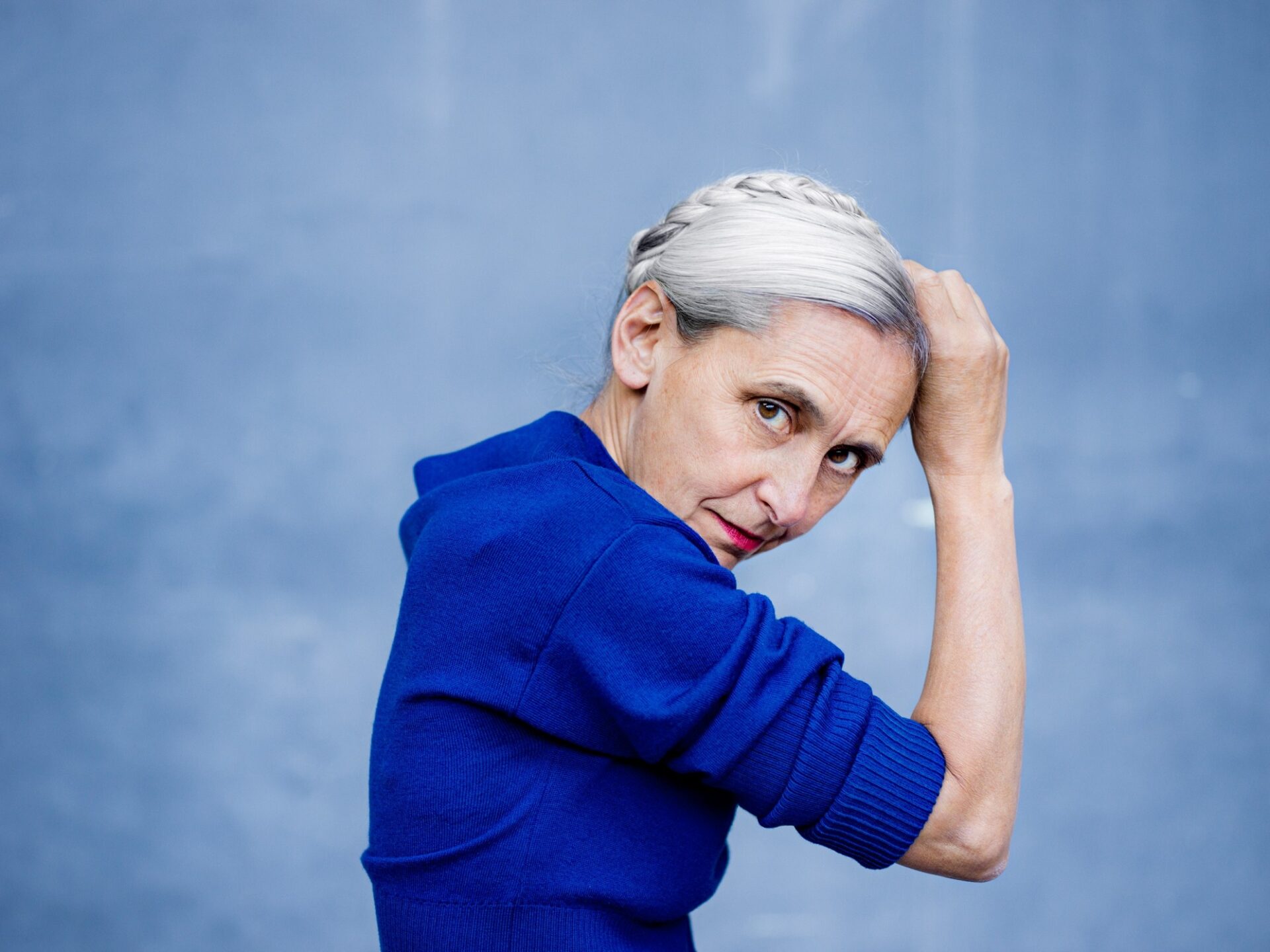The brightly coloured tape covering the floor is placed in large round shapes and pieces criss-crossing each other. If it was on the pavement, we would call it street art. Here in one of the studios at the Rosas dance company in Brussels, it is a roadmap to where your legs must take you next.
It illustrates how contemporary dance is controlled chaos. What can seem random and wild to an audience is precisely planned, centimetre by centimetre. This is no more evident than in the work of Anne Teresa De Keersmaeker, the founder of the Rosas and the P.A.R.T.S. dance school. “Complex simplicity” she calls it. “Something very structured, very formal but at the same time fun.”
The choreographer is fresh from the first run of her new work, Exit Above: After the Tempest, which premiered at Théâtre National in Brussels. It will now tour Europe before returning to stages in Antwerp, Ghent and Aalst.
De Keersmaeker’s air is one of casual sophistication, her clothes stylish but loose-fitting – for maximum movement at a moment’s notice. We talk across a table in Rosas’ labyrinth of a building on the Avenue Van Volxem in Forest.
Arguably the world’s most celebrated dancer and choreographer, De Keersmaeker has produced a vast body of work over four decades, from major theatre productions to site-specific performances in museums, forests or cloisters.
And she isn’t stopping anytime soon. “We don’t have products,” she says. “With a movie, you make it, and it lasts forever. With music, you make a recording. But with us, it has to be embodied over and over again.”

Scene from Exit Above: After the Tempest
Her style is variously described as geometrical, repetitive and minimalist. Some of de Keersmaeker’s seminal works – Fase, Four Movements to the Music of Steve Reich, Achterland, Rosas danst Rosas, Drumming, Rain – rely on near empty stages, scrupulous compositions and recurrence of movements.
On paper, this can sound cold and tedious. But when performed, there is an energy and urgency to the dances: a flailing of limbs in tandem, over and over, the same roll across the floor, the same stomp of a foot, again and again, the same symmetrical circle, around and around. There is a tribal vibrancy in De Keersmaeker’s work, the sense that we must use our bodies persistently to conjure something vital.
Embodying music
Now 62, De Keersmaeker has created choreography as living exhibitions in museums, made films of her work, directed operas, founded a dance school, and been made a baroness by King Albert II. Yet she still strives to embody music. Her choreography doesn’t just move to the beat. It is the beat, what the sound looks like to the eye rather than the ear.
She has a fondness for minimalist composers like Steve Reich and John Cage, but she also embraces classical composers such as Bach and Mozart, jazz master Miles Davis and ensemble AKA Moon and pop artist Brian Eno. In Achterland, a single unbridled violinist is on stage, while at other times there are as many musicians on view as there are dancers.
De Keersmaeker studied the flute as a child and still knows how to play – “though less and less over the last few years,” she says. “I do know how to read notes and scores. I learn so much from composers. I am always surrounded by very great musicians and music from many different periods.”
For Exit Above: After the Tempest, De Keersmaeker turned to the blues. “I wanted to go back to pop music,” she says. “I tried to go to the origins. And one of the origins of pop music is, of course, the blues.”

Scene from Exit Above: After the Tempest
She also had the ideal collaborator: producer and guitarist Jean-Marie Aerts of the 1980s Belgian rock band TC Matic. Sometime earlier she was going through her record collection and a note from Aerts fell from one of the sleeves with his phone number. The album was from 1996, but she called the number anyway. Aerts picked up the phone.
They began to talk about the blues. “There are pictures of Billie Holiday and Robert Johnson hanging in his studio,” says De Keersmaeker. “I wanted music that was danceable but also with a text, so that there is storytelling, verbalised emotion.”
She wanted a woman’s voice and remembered Meskerem Mees, who won the Humo’s Rock Rally in 2020 with her clear, emotion-laden voice, creative songwriting and simple acoustic guitar. “She’s an extremely talented, authentic young woman,” De Keersmaeker says. “I’ve always tried to have high standards in the musicians I work with, and that was no different this time.”
De Keersmaeker also put her on stage: Mees not only sings in the production but dances and plays the saxophone. “She was very involved in the whole creation process,” explains De Keersmaeker. “I usually begin by providing starting points and making decisions, and then often work with movement that dancers propose, and so that was also the case with her.”
Mees and Aerts composed the music for Exit Above: After The Tempest, with Rosas dancer-cum-blues guitarist Carlos Garbin, bringing together chanson, blues and rock.
And Shakespeare – and not for the first time for De Keersmaeker. Back in 2015, she choreographed As You Like It, which used the sounds of Brian Eno’s album Golden Hours, while the dancers wordlessly danced the rhythm of Shakespeare’s lines.
This time the complex, magical Shakespearean tale is more of an inspiration that somehow connects with the blues. “The Tempest starts with the storm, a vessel that is destroyed by water and fire,” says De Keersmaeker, “Blues songs are rooted in the Mississippi Delta. They speak of the sadness and joy on a personal level but also of dealing with the floods and the impact of nature on their lives and facing extreme situations.”
Serious and solemn
De Keersmaeker speaks quietly and quickly. She is serious and solemn – until asked about Brussels when she started out in the early 1980s. She recalls how back in 1982, when she was just 22, she smoked and ate wantonly, the antithesis of the health-obsessed dancers of the day. While she has long given up smoking, one gets the impression she still refuses to diet.

Anne Teresa De Keersmaeker in her studio
Back then, De Keersmaeker had just booked her first big success with Fase: Four Movements to the Music of Steve Reich. She created it in New York where she was studying at NYU’s dance department, following two years of training at Maurice Béjart’s Mudra school of dance.
“The history of modern dance and postmodern dance is related to the history of American culture,” she says. “The great names of modern and postmodern dance – Isadora Duncan, Martha Graham, Trisha Brown, Yvonne Rainer, Merce Cunningham, Steve Paxton – they are all American based.”
Dance in New York, she says, was all around, “part of your daily life,” she says. “I was in this environment where there was a lot of contemporary and modern dance, postmodern dance. That was extremely nourishing. And you know, I was only 20, so it was really exciting. I worked very hard, but I had a lot of fun.”
She had already created a site-specific performance in Brussels called Asche, but it was Fase that launched her career. She set four short dances to the music of minimalist composer Steve Reich, working directly with his musicians. Of the four, she names Violin Phase as her seminal piece: danced in sand, the dancer slowly creates a flower-like circular pattern with largely repetitive movements. “There is a notion of freedom,” she reflects. “Maximising freedom within a very tight structure.”
Fase has since been recognised as a masterpiece of contemporary dance. De Keersmaeker thinks the piece struck a chord for its portrayal of “dance like music, dance like a process. It seems structural and mathematical but had very intense physicality that brought to the surface some kind of emotions. That beautiful balance between formal and a kind of loose playfulness.”
De Keersmaeker returned to Brussels. “It was a completely different city in the ’80s. There was an exodus of a lot of young people, young families who left the city, so the centre was empty, it was just empty,” she says.
Many young talents might have gone somewhere with a more established scene – Berlin, London, or even back to New York. “Well, even a wasteland can be nice,” she responds. “There were a few cafes, everybody found each other. I met the right people at the right time, we created this collective of young artists. We were helping each other; some were creating, others were performing. I was born near Brussels, it has always been my city. I love New York, but Brussels was a city that was betwixt and between. That kept me here.”
She eventually won funding and founded Rosas. Her production, Rosas danst Rosas, furthered solidified her place in European contemporary dance. It features four women performing repetitive movements wildly, sometimes from their straight, wooden chairs, sometimes rolling on the floor. Their schoolgirl-like garb suggests a world in which conformity is demanded, their movements a desperation to break free.
Co-composer Thierry De Mey made an atmospheric film of the piece in an abandoned school originally built by Henry Van de Velde in Leuven. It opens up the work’s many interpretations to a YouTube-obsessed world. This is likely where Beyoncé discovered it when she sampled it for her 2011 video Countdown.
Following complaints from Rosas that the American superstar copied the work without permission nor compensation, the Countdown video was adapted, but Rosas can still be seen, right down to the look of the building.
De Keersmaeker had mixed feelings about it at the time, telling VRT that Beyoncé was certainly not the worst copycat her work could have had. But now, she doesn’t want to discuss them, responding to questions about it with a firm “no comment”.
The Brussels opera house recognised her choreography much sooner: in 1995, Rosas was asked to become La Monnaie’s resident dance company. At the same time, she founded P.A.R.T.S., inspired by Béjart’s Mudra.
It was a special moment. In the 1990s, she says, a generation of young Belgian theatre directors and choreographers had emerged, seeking inspiration from anywhere and anytime. “What you take from the past, where you are now, and what you want to take forward to build, to shape, to imagine the future,” she says.
P.A.R.T.S. is now based next to Rosas in Forest. “It was good to take back what Béjart had started and to establish a school that was based on my experience as a student, as a dancer, as a choreographer, but also as a spectator. And to open it up to a wider community of all those artists who work in Brussels,” she says.
Despite her success, De Keersmaeker says that “the work is never done”. This could be why, at a time in life when many professionals are thinking about retirement, De Keersmaeker shows no sign of slowing down. “The question of stopping is never raised when we talk about painters and writers,” she says. “I think for choreographers it is raised because it’s so much related to the body, and the body is really where you see the passage of time. You do think about different things when you are 20 than when you are 60. I think the most challenging and most beautiful is the transmission to future generations, so that you can create both continuity and differentiation.”

